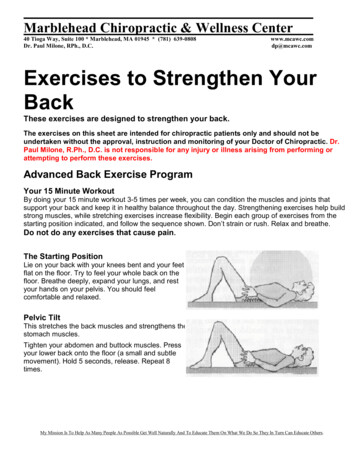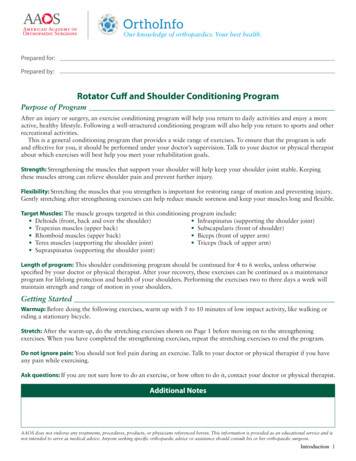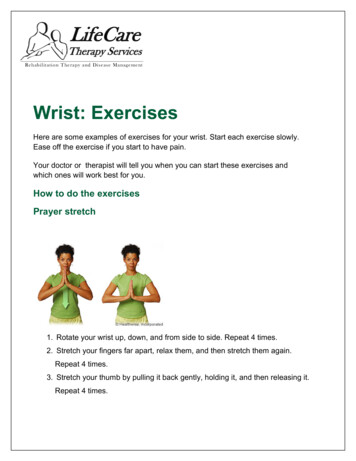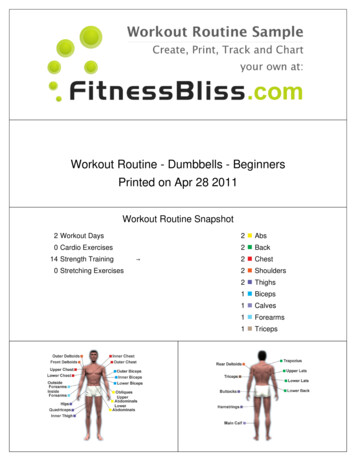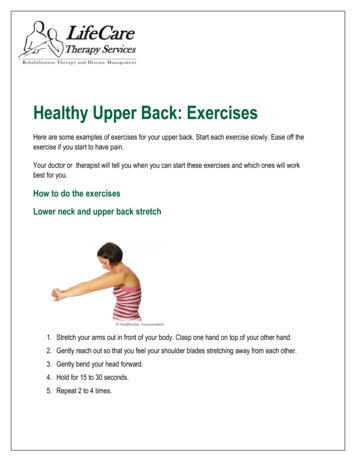
Transcription
LifeCareTherapy ServicesReh abil ita t ion Therap y and D isease Man ag em en tHealthy Upper Back: ExercisesHere are some examples of exercises for your upper back. Start each exercise slowly. Ease off theexercise if you start to have pain.Your doctor or therapist will tell you when you can start these exercises and which ones will workbest for you.How to do the exercisesLower neck and upper back stretch1. Stretch your arms out in front of your body. Clasp one hand on top of your other hand.2. Gently reach out so that you feel your shoulder blades stretching away from each other.3. Gently bend your head forward.4. Hold for 15 to 30 seconds.5. Repeat 2 to 4 times.
Healthy Upper Back: Exercises (page 2)Midback stretchNote: If you have knee pain, do not do this exercise.1. Kneel on the floor, and sit back on your ankles.2. Lean forward, place your hands on the floor, and stretch your arms out in front of you. Rest yourhead between your arms.3. Gently push your chest toward the floor, reaching as far in front of you as possible.4. Hold for 15 to 30 seconds.5. Repeat 2 to 4 times.Shoulder rolls1. Sit comfortably with your feet shoulder-width apart. You can also do this exercise while standing.2. Roll your shoulders up, then back, and then down in a smooth, circular motion.3. Repeat 2 to 4 times.
Healthy Upper Back: Exercises (page 3)Wall push-up1. Stand against a wall with your feet about 12 to 24 inches back from the wall. If you feel any painwhen you do this exercise, stand closer to the wall.2. Place your hands on the wall slightly wider apart than your shoulders, and lean forward.3. Gently lean your body toward the wall. Then push back to your starting position. Keep the motionsmooth and controlled.4. Repeat 8 to 12 times.Resisted shoulder blade squeezeNote: For this exercise, you will need elastic exercise material, such as surgical tubing or Thera-band.1. Sit or stand, holding the band in both hands in front of you. Keep your elbows close to yoursides, bent at a 90-degree angle. Your palms should face up.2. Squeeze your shoulder blades together, and move your arms to the outside, stretching the band.Be sure to keep your elbows at your sides while you do this.
Healthy Upper Back: Exercises (page 4)3. Relax.4. Repeat 8 to 12 times.Resisted rowsNote: For this exercise, you will need elastic exercise material, such as surgical tubing or Thera-band.1. Put the band around a solid object, such as a bedpost, at about waist level. Hold one end of theband in each hand.2. With your elbows at your sides and bent to 90 degrees, pull the band back to move yourshoulder blades toward each other. Return to the starting position.3. Repeat 8 to 12 times.Follow-up care is a key part of your treatment and safety. Be sure to make and go to allappointments, and call your doctor if you are having problems. It's also a good idea to know your testresults and keep a list of the medicines you take.
LifeCareTherapy ServicesReh abil ita t ion Therap y and D ise ase Man ag em en tNeck Spasm: ExercisesHere are some examples of typical rehabilitation exercises for your condition. Start each exercise slowly.Ease off the exercise if you start to have pain.Your doctor or therapist will tell you when you can start these exercises and which ones will workbest for you.How to do the exercisesLevator scapula stretch1. Sit in a firm chair, or stand up straight.2. Gently tilt your head toward your left shoulder.3. Turn your head to look down into your armpit, bending your head slightly forward. Let the weightof your head stretch your neck muscles.4. Hold for 15 to 30 seconds.5. Return to your starting position.
Neck Spasm: Exercises (page 2)6. Follow the same instructions above, but tilt your head toward your right shoulder.7. Repeat 2 to 4 times toward each shoulder.Upper trapezius stretch1. Sit in a firm chair, or stand up straight.2. This stretch works best if you keep your shoulder down as you lean away from it. To help youremember to do this, start by relaxing your shoulders and lightly holding on to your thighs or yourchair.3. Tilt your head toward your shoulder and hold for 15 to 30 seconds. Let the weight of your headstretch your muscles.4. If you would like a little added stretch, place your arm behind your back. Use the arm opposite ofthe direction you are tilting your head. For example, if you are tilting your head to the left, placeyour right arm behind your back.5. Repeat 2 to 4 times toward each shoulder.Neck rotation
Neck Spasm: Exercises (page 3)1. Sit in a firm chair, or stand up straight.2. Keeping your chin level, turn your head to the right, and hold for 15 to 30 seconds.3. Turn your head to the left, and hold for 15 to 30 seconds.4. Repeat 2 to 4 times to each side.Chin tuck1. Lie on the floor with a rolled-up towel under your neck. Your head should be touching the floor.2. Slowly bring your chin toward the front of your neck.3. Hold for a count of 6, and then relax for up to 10 seconds.4. Repeat 8 to 12 times.Forward neck flexion1. Sit in a firm chair, or stand up straight.2. Bend your head forward.
Neck Spasm: Exercises (page 4)3. Hold for 15 to 30 seconds, then return to your starting position.4. Repeat 2 to 4 times.Follow-up care is a key part of your treatment and safety. Be sure to make and go to allappointments, and call your doctor if you are having problems. It's also a good idea to know your testresults and keep a list of the medicines you take.
LifeCareTherapy ServicesReh abil ita t ion Therap y and D isease Man ag em en tBack Stretches: ExercisesHere are some examples of exercises for stretching your back. Start each exercise slowly. Ease off theexercise if you start to have pain.Your doctor or therapist will tell you when you can start these exercises and which ones will workbest for you.How to do the exercisesOverhead stretch1. Stand comfortably with your feet shoulder-width apart.2. Looking straight ahead, raise both arms over your head and reach toward the ceiling. Do notallow your head to tilt back.3. Hold for 15 to 30 seconds, then lower your arms to your sides.4. Repeat 2 to 4 times.
Back Stretches: Exercises (page 2)Side stretch1. Stand comfortably with your feet shoulder-width apart.2. Raise one arm over your head, and then lean to the other side.3. Slide your hand down your leg as you let the weight of your arm gently stretch your sidemuscles. Hold for 15 to 30 seconds.4. Repeat 2 to 4 times on each side.Press-up1. Lie on your stomach, supporting your body with your forearms.2. Press your elbows down into the floor to raise your upper back. As you do this, relax yourstomach muscles and allow your back to arch without using your back muscles. As your pressup, do not let your hips or pelvis come off the floor.3. Hold for 15 to 30 seconds, then relax.4. Repeat 2 to 4 times.
Back Stretches: Exercises (page 3)Relax and rest1. Lie on your back with a rolled towel under your neck and a pillow under your knees. Extend yourarms comfortably to your sides.2. Relax and breathe normally.3. Remain in this position for about 10 minutes.4. If you can, do this 2 or 3 times each day.Follow-up care is a key part of your treatment and safety. Be sure to make and go to allappointments, and call your doctor if you are having problems. It's also a good idea to know your testresults and keep a list of the medicines you take.
LifeCareTherapy ServicesReh abil ita t ion Therap y and D ise ase Man ag em en tLow Back Pain: ExercisesHere are some examples of typical rehabilitation exercises for your condition. Start each exercise slowly.Ease off the exercise if you start to have pain.Your doctor or therapist will tell you when you can start these exercises and which ones will workbest for you.How to do the exercisesPress-up1. Lie on your stomach, supporting your body with your forearms.2. Press your elbows down into the floor to raise your upper back. As you do this, relax yourstomach muscles and allow your back to arch without using your back muscles. As your pressup, do not let your hips or pelvis come off the floor.3. Hold for 15 to 30 seconds, then relax.4. Repeat 2 to 4 times.
Low Back Pain: Exercises (page 2)Alternate arm and leg (bird dog) exerciseNote: Do this exercise slowly. Try to keep your body straight at all times, and do not let one hip droplower than the other.1. Start on the floor, on your hands and knees.2. Tighten your belly muscles.3. Raise one leg off the floor, and hold it straight out behind you. Be careful not to let your hip dropdown, because that will twist your trunk.4. Hold for about 6 seconds, then lower your leg and switch to the other leg.5. Repeat 8 to 12 times on each leg.6. Over time, work up to holding for 10 to 30 seconds each time.7. If you feel stable and secure with your leg raised, try raising the opposite arm straight out in frontof you at the same time.Knee-to-chest exercise
Low Back Pain: Exercises (page 3)1. Lie on your back with your knees bent and your feet flat on the floor.2. Bring one knee to your chest, keeping the other foot flat on the floor (or keeping the other legstraight, whichever feels better on your lower back).3. Keep your lower back pressed to the floor. Hold for at least 15 to 30 seconds.4. Relax, and lower the knee to the starting position.5. Repeat with the other leg. Repeat 2 to 4 times with each leg.6. To get more stretch, put your other leg flat on the floor while pulling your knee to your chest.Curl-ups1. Lie on the floor on your back with your knees bent at a 90-degree angle. Your feet should be flaton the floor, about 12 inches from your buttocks.2. Cross your arms over your chest.3. Slowly tighten your belly muscles and raise your shoulder blades off the floor.4. Keep your head in line with your body, and do not press your chin to your chest.5. Hold this position for 1 or 2 seconds, then slowly lower yourself back down to the floor.6. Repeat 8 to 12 times.
Low Back Pain: Exercises (page 4)Pelvic tilt exercise1. Lie on your back with your knees bent.2. "Brace" your stomach. This means to tighten your muscles by pulling in and imagining your bellybutton moving toward your spine. You should feel like your back is pressing to the floor and yourhips and pelvis are rocking back.3. Hold for about 6 seconds while you breathe smoothly.4. Repeat 8 to 12 times.Heel dig bridging1. Lie on your back with both knees bent and your ankles bent so that only your heels are digginginto the floor. Your knees should be bent about 90 degrees.2. Then push your heels into the floor, squeeze your buttocks, and lift your hips off the floor untilyour shoulders, hips, and knees are all in a straight line.3. Hold for about 6 seconds as you continue to breathe normally, and then slowly lower your hipsback down to the floor and rest for up to 10 seconds.
Low Back Pain: Exercises (page 5)4. Do 8 to 12 repetitions.Hamstring stretch in doorway1. Lie on your back in a doorway, with one leg through the open door.2. Slide your leg up the wall to straighten your knee. You should feel a gentle stretch down the backof your leg.3. Hold the stretch for at least 15 to 30 seconds. Do not arch your back, point your toes, or bendeither knee. Keep one heel touching the floor and the other heel touching the wall.4. Repeat with your other leg.5. Do 2 to 4 times for each leg.Hip flexor stretch1. Kneel on the floor with one knee bent and one leg behind you. Place your forward knee overyour foot. Keep your other knee touching the floor.2. Slowly push your hips forward until you feel a stretch in the upper thigh of your rear leg.
Low Back Pain: Exercises (page 6)3. Hold the stretch for at least 15 to 30 seconds. Repeat with your other leg.4. Do 2 to 4 times on each side.Wall sit1. Stand with your back 10 to 12 inches away from a wall.2. Lean into the wall until your back is flat against it.3. Slowly slide down until your knees are slightly bent, pressing your lower back into the wall.4. Hold for about 6 seconds, then slide back up the wall.5. Repeat 8 to 12 times.Follow-up care is a key part of your treatment and safety. Be sure to make and go to allappointments, and call your doctor if you are having problems. It's also a good idea to know your testresults and keep a list of the medicines you take.
LifeCareTherapy ServicesReh abil ita t ion Therap y and D isease Man ag em en tPiriformis Syndrome: ExercisesHere are some examples of typical rehabilitation exercises for your condition. Start each exercise slowly.Ease off the exercise if you start to have pain.Your doctor or therapist will tell you when you can start these exercises and which ones will workbest for you.How to do the exercisesHip rotator stretch1. Lie on your back with both knees bent and your feet flat on the floor.2. Put the ankle of your affected leg on your opposite thigh near your knee.3. Use your hand to gently push your knee (on your affected leg) away from your body until you feela gentle stretch around your hip.4. Hold the stretch for 15 to 30 seconds.5. Repeat 2 to 4 times.
Piriformis Syndrome: Exercises (page 2)6. Switch legs and repeat steps 1 through 5.Piriformis stretch1. Lie on your back with your legs straight.2. Lift your affected leg and bend your knee. With your opposite hand, reach across your body, andthen gently pull your knee toward your opposite shoulder.3. Hold the stretch for 15 to 30 seconds.4. Repeat with your other leg.5. Repeat 2 to 4 times on each side.Lower abdominal strengthening1. Lie on your back with your knees bent and your feet flat on the floor.2. Tighten your belly muscles by pulling your belly button in toward your spine.3. Lift one foot off the floor and bring your knee toward your chest, so that your knee is straightabove your hip and your leg is bent like the letter "L."
Piriformis Syndrome: Exercises (page 3)4. Lift the other knee up to the same position.5. Lower one leg at a time to the starting position.6. Keep alternating legs until you have lifted each leg 8 to 12 times.7. Be sure to keep your belly muscles tight and your back still as you are moving your legs. Be sureto breathe normally.Follow-up care is a key part of your treatment and safety. Be sure to make and go to allappointments, and call your doctor if you are having problems. It's also a good idea to know your testresults and keep a list of the medicines you take.
Midback stretch Note: If you have knee pain, do not do this exercise. 1. Kneel on the floor, and sit

